In the vibrant world of the Red-Crested Pochard (Netta rufina), a striking waterfowl species renowned for its captivating appearance and unique characteristics.
With its distinctive red crest and colorful plumage, the Red-Crested Pochard stands out as a jewel among waterbirds, captivating the attention of birdwatchers and nature enthusiasts worldwide.
This elegant species inhabits various wetland habitats, including lakes, ponds, marshes, and rivers, where it can be observed gracefully swimming and foraging for food.
Beyond its aesthetic appeal, the Red-Crested Pochard plays a vital role in maintaining the ecological balance of its habitats, contributing to nutrient cycling and biodiversity.
Join us on a journey into the world of the Red-Crested Pochard as we delve into its biology, behavior, habitat preferences, and conservation status.
Discover the secrets of this remarkable waterfowl and gain a deeper appreciation for the natural wonders that grace our planet’s wetlands.
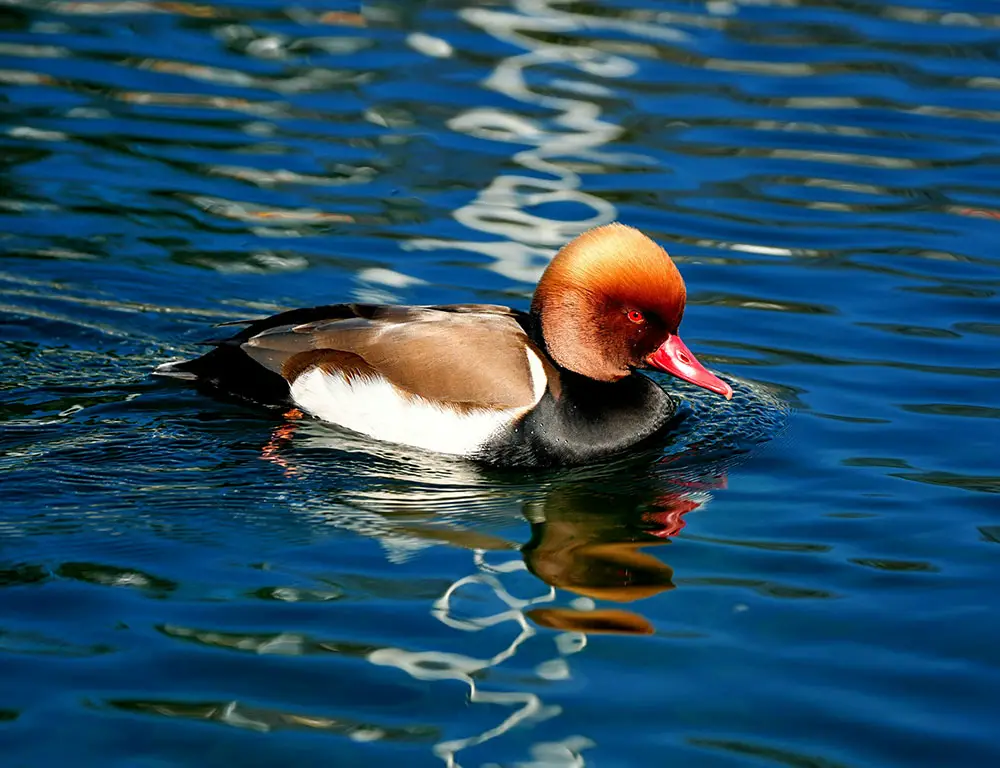
Describing the Key Physical Characteristics of the Red-Crested Pochard
The Red-Crested Pochard is a striking waterfowl species known for its vibrant plumage and unique physical features. Here are the key characteristics that distinguish the Red-Crested Pochard:
Plumage
One of the most distinctive features of the Red-Crested Pochard is its colorful plumage. Adult males have a glossy chestnut-red head and neck, contrasting sharply with their black breast and back. They also have bright red eyes and a distinctive red bill with a black tip.
The body is predominantly grayish-white with black markings, and the wings display iridescent blue and green patches in flight. In contrast, females and juveniles have more subdued plumage, with mottled brown and gray feathers.
Red Crest
As its name suggests, the Red-Crested Pochard is characterized by a striking red crest on its head. This crest is composed of elongated feathers that can be raised or lowered depending on the bird’s mood or behavior.
The vibrant red coloration of the crest serves as a visual signal during courtship displays and social interactions.
Size
Red-Crested Pochards are medium-sized ducks, with adult males typically measuring around 45 to 55 centimeters (18 to 22 inches) in length and weighing between 800 to 1,200 grams (1.8 to 2.6 pounds).
Females are slightly smaller, measuring around 40 to 50 centimeters (16 to 20 inches) in length and weighing 600 to 1,000 grams (1.3 to 2.2 pounds).
Bill and Feet
The bill of the Red-Crested Pochard is short and broad, with a distinctive shape adapted for dabbling and filter-feeding. It is predominantly red with a black tip.
The legs and feet are also red, providing a striking contrast against the bird’s overall plumage. These adaptations enable the Red-Crested Pochard to forage efficiently in shallow water habitats.
Sexual Dimorphism
Sexual dimorphism is evident in the plumage of adult Red-Crested Pochards, with males displaying more vibrant colors and distinctive markings than females.
Additionally, males have a larger and more prominent red crest than females, which may play a role in attracting mates during the breeding season.
Vocalizations
Red-crested pochards are relatively quiet compared to other waterfowl species, but they produce various vocalizations for communication and social interactions.
These include soft grunts, whistles, and quacks used during courtship displays, territorial disputes, and group communication.
Flight Pattern
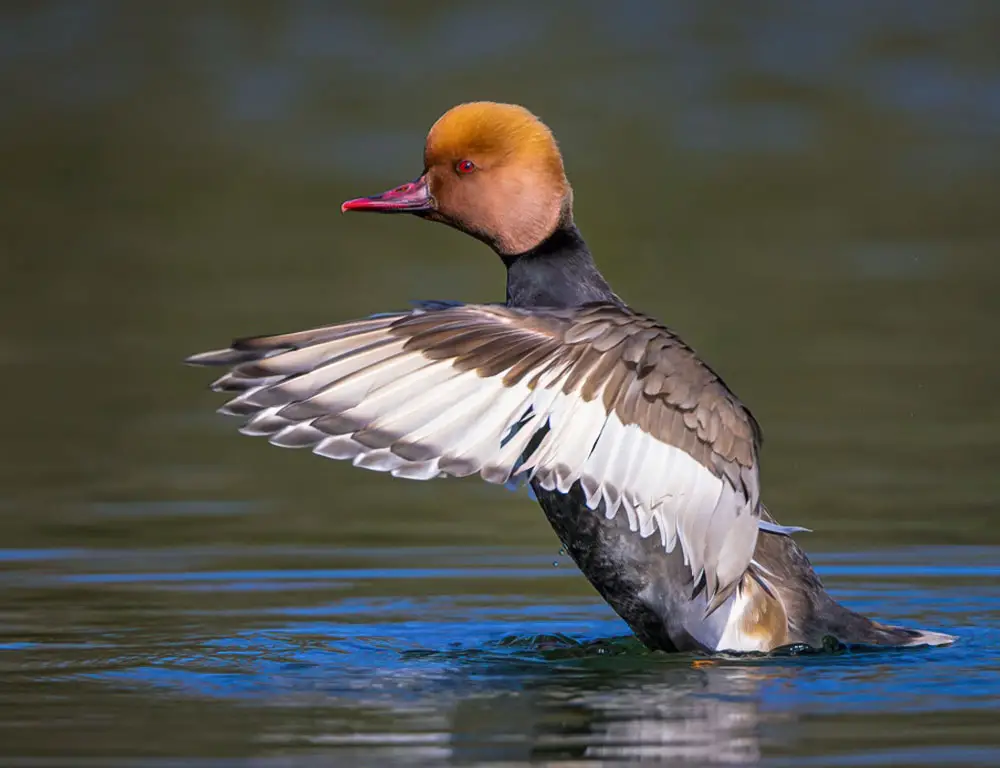
Red-crested pochards display agile and graceful movements in flight, with steady wingbeats and smooth glides. Their broad and pointed wings enable them to maneuver easily through the air.
During migration, flocks of Red-Crested Pochards may form V-shaped or irregular formations as they travel between their breeding and wintering grounds.
Breeding and Food Habits of the Greater Red-Crested Pochard
Discover the Greater Red-Crested Pochard’s fascinating breeding behaviors and dietary preferences, shedding light on its role in the ecosystem and conservation efforts.
Taxonomy
| Taxonomy Level | Classification |
| Kingdom | Animalia |
| Phylum | Chordata |
| Class | Aves |
| Order | Anseriformes |
| Family | Anatidae |
| Genus | Netta |
| Species | Netta rufina |
Food Habitat
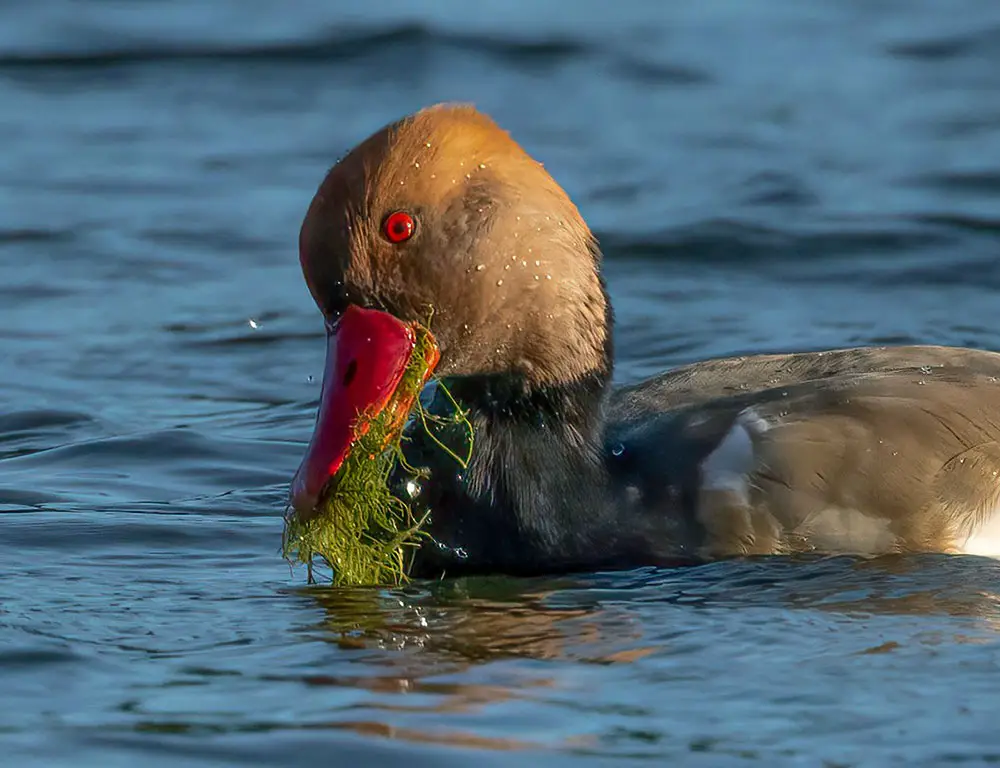
Greater Red-Crested Pochards are omnivorous birds that feed primarily on aquatic vegetation, seeds, and small invertebrates. Their diet may vary depending on the availability of food resources in their habitat.
They are commonly found foraging in shallow freshwater habitats such as lakes, ponds, marshes, and slow-moving rivers.
During the breeding season, they may also consume aquatic insects and crustaceans to supplement their diet and provide essential nutrients for egg production and chick rearing.
Nesting
| Nest Site Selection | Description |
| Nest Location | Greater Red-Crested Pochards typically nest near water bodies, constructing their nests on floating vegetation or among dense emergent vegetation along the shoreline. |
| Nest Construction | Breeding season varies depending on geographic location, with nesting typically occurring in the spring and early summer. |
| Nesting Season | Breeding season varies depending on geographic location, with nesting typically occurring in the spring and early summer months. |
| Clutch Size | Clutch sizes range from 8 to 12 eggs, with the female incubating the eggs for approximately 25 to 28 days while the male stands guard nearby. |
| Incubation Period | Incubation lasts approximately 25 to 28 days, during which the female remains dedicated to keeping the eggs warm and protected. |
| Fledging and Growth | Chicks hatch precocial, with their eyes open and covered in down feathers. They are capable of swimming and foraging shortly after hatching and remain under the care of both parents until they fledge at around 6 to 8 weeks of age. |
Breeding
Pair bonding, courtship displays, and nest construction characterize the breeding behaviors of Greater Red-Crested Pochards.
Breeding pairs typically form during the wintering season and return to their breeding grounds in the spring to establish nesting territories.
Males use elaborate courtship displays to attract females, including head bobbing, wing flapping, and vocalizations.
Once a suitable nesting site is selected, females construct nests using plant materials and down feathers, where they lay and incubate their eggs.
Both parents participate in caring for the young, providing protection, warmth, and food until the chicks are ready to fledge and become independent.
Conservation Status
The conservation status of the Greater Red-Crested Pochard varies depending on geographic populations.
While some populations may face habitat loss, pollution, and hunting pressure threats, the species maintains stable populations across its range.
Conservation efforts focused on habitat preservation, wetland restoration, and sustainable management practices are essential for ensuring the continued survival of this iconic waterfowl species and the ecosystems it inhabits.
Range Map and Common Diseases of the Red-Crested Pochard
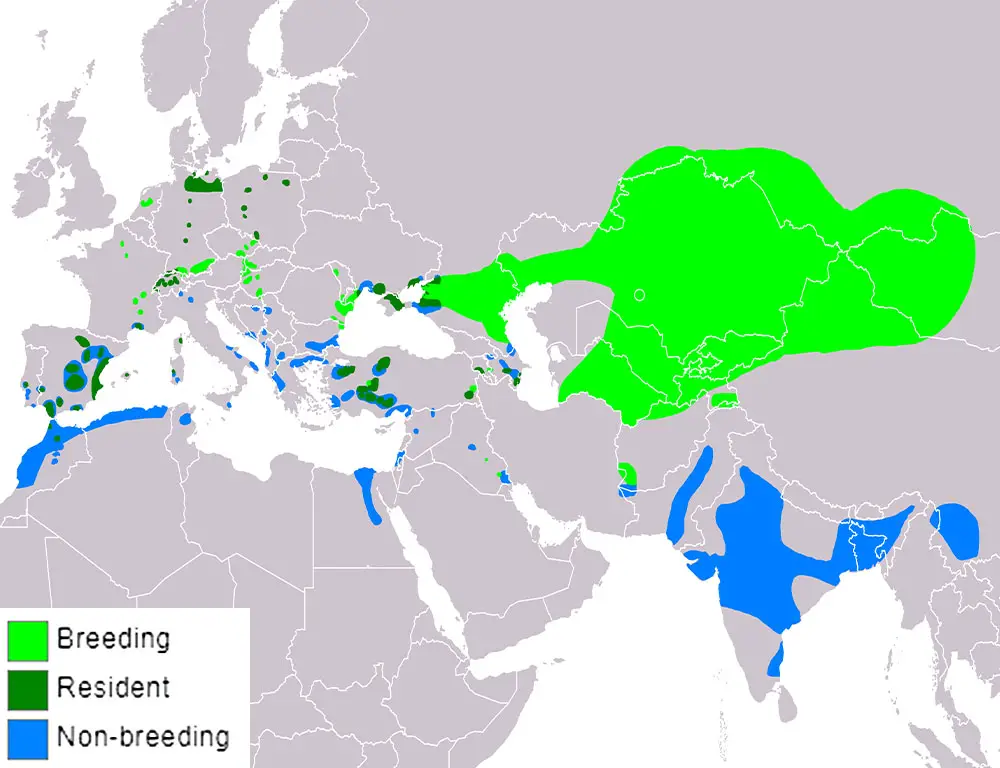
The Red-Crested Pochard is a widespread species in Europe, Asia, and Africa. Its range extends from southern and central Europe to central and west Asia, including Spain, France, Italy, Greece, Turkey, Iran, and India.
It also occurs in northern Africa, particularly Egypt, Tunisia, and Algeria. In some regions, the Red-Crested Pochard is a resident species; in others, it is migratory, moving between breeding and wintering grounds.
During the breeding season, it inhabits freshwater habitats such as lakes, marshes, and ponds, while in winter, it may also occur in coastal wetlands and estuaries. Here are some common diseases and treatments of the Red-Crested Pochard:
Avian Botulism
Avian botulism is a bacterial disease that affects waterfowl species like the Red-Crested Pochard. It is caused by ingesting toxins produced by the bacterium Clostridium botulinum, which contaminates water bodies.
Treatment involves supportive care, including fluid therapy and nutrition, and administering antitoxin if available.
Aspergillosis
Aspergillosis is a fungal infection that can affect the respiratory system of birds, including ducks. It is caused by inhaling spores of the fungus Aspergillus, which can increase in damp environments.
Treatment may involve antifungal medications administered orally or via nebulization and supportive care to improve respiratory function.
Lead Poisoning
Lead poisoning can occur in waterfowl like the Red-Crested Pochard by ingesting lead-based ammunition or fishing tackle. Lead toxicity can cause neurological and gastrointestinal symptoms and can be fatal if not treated promptly.
Treatment typically involves chelation therapy to remove lead from the body and supportive care to manage symptoms.
Parasitic Infections
Ducks may be susceptible to various parasitic infections, including internal parasites such as roundworms and tapeworms and external parasites like lice and mites.
Treatment involves deworming medications for internal parasites and insecticidal treatments or bathing for external parasites.
Avian Influenza
Avian influenza is a viral disease that can affect waterfowl populations, including the Red-Crested Pochard. Infected birds may experience respiratory symptoms, decreased appetite, and lethargy.
Treatment is limited, and affected birds may require supportive care to manage symptoms and prevent secondary infections.
6 Fun Facts About the Red-Crested Pochard
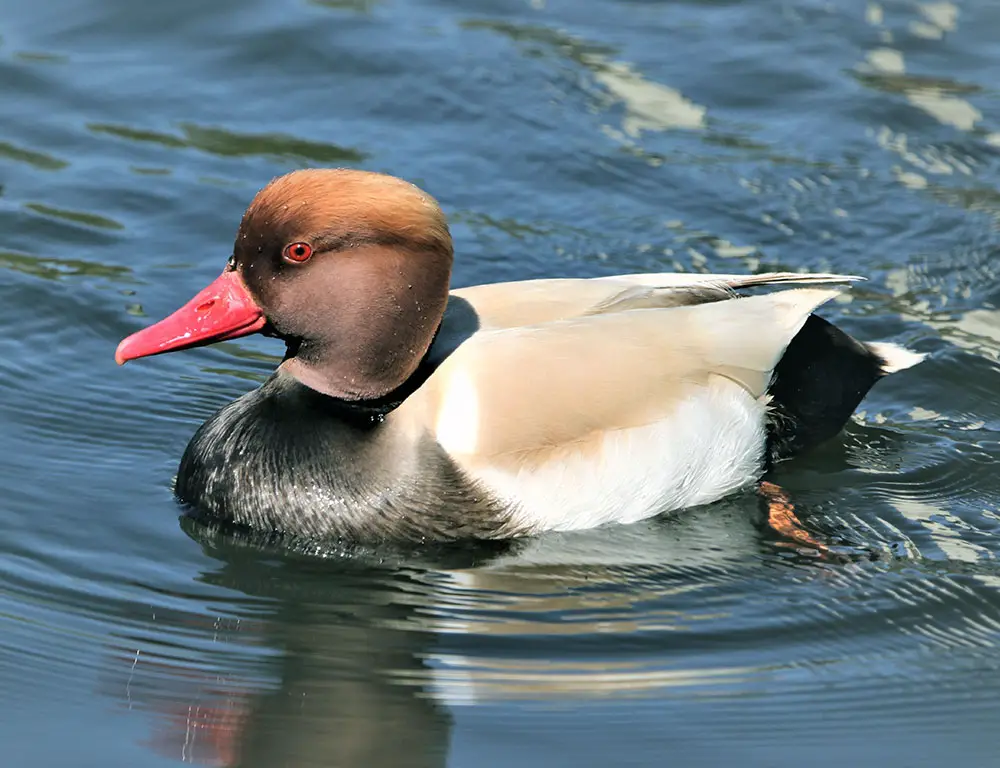
Explore the fascinating world of the Red-Crested Pochard with these intriguing facts that showcase its unique characteristics and behaviors.
1. Diving Ducks
Red-crested pochards are classified as diving ducks, capable of diving underwater to forage for food. They can remain submerged for up to 30 seconds while searching for aquatic plants, seeds, and invertebrates.
2. Social Birds
These ducks are often found in large flocks, particularly during winter, when they gather in wetlands and water bodies. They engage in social behaviors such as synchronized swimming and group foraging.
3. Breeding Displays
During the breeding season, male Red-Crested Pochards perform elaborate courtship displays to attract females. These displays may include head bobbing, wing flapping, and vocalizations to demonstrate their fitness and readiness to mate.
4. Migratory Behavior
While some populations of Red-Crested Pochards are resident year-round, others undertake seasonal migrations between breeding and wintering grounds.
Following established flyways, their migratory journeys can span hundreds or even thousands of kilometers.
5. Hybridization
Red-Crested Pochards are known to hybridize with other duck species, particularly the Common Pochard (Aythya ferina). Hybrid offspring may display traits from both parent species and can be found in areas where their ranges overlap.
6. Conservation Concerns
Despite being classified as a species of “Least Concern” by the IUCN, the Red-Crested Pochard faces threats from habitat loss, pollution, and hunting pressure in some regions.
Conservation efforts are underway to protect critical wetland habitats and promote sustainable management practices to ensure the long-term survival of this species.
FAQs
Where can Red-Crested Pochards be found?
Red-Crested Pochards are distributed across Europe, Asia, and parts of Africa. They inhabit freshwater habitats such as lakes, ponds, marshes, and rivers, where they can be observed diving for food and engaging in social behaviors.
What do Red-Crested Pochards eat?
Red-Crested Pochards are omnivorous ducks that primarily feed on aquatic vegetation, seeds, and small invertebrates. They use their specialized bills to filter food from the water or dive to reach submerged plants and prey.
Are Red-Crested Pochards migratory birds?
While some populations of Red-Crested Pochards are resident year-round, others are migratory and undertake seasonal migrations between breeding and wintering grounds.
Their migratory patterns vary depending on geographic location and environmental conditions.
How do Red-Crested Pochards reproduce?
Red-Crested Pochards form pair bonds during the breeding season, with males performing elaborate courtship displays to attract females.
Once paired, females construct nests near water bodies and lay a clutch of eggs, which they incubate until they hatch. Both parents participate in caring for the young until they fledge.
How do Red-Crested Pochards differ from other duck species?
Red-Crested Pochards are distinguished by their striking plumage: glossy chestnut-red head and neck, bright red eyes, and a distinctive red crest.
Compared to other duck species, they have a unique diving behavior and are often found in large flocks, particularly during winter.
Conclusion
The Red-Crested Pochard stands as a testament to the beauty and diversity of avian life, captivating observers with its vibrant plumage and graceful presence.
As stewards of the natural world, we are responsible for safeguarding the habitats and ecosystems that support populations of Red-Crested Pochards and other waterfowl species.
Conservation efforts focused on habitat preservation, wetland restoration, and sustainable management practices are essential for ensuring the continued survival of the Red-Crested Pochard and the ecosystems it inhabits.
By working together to address threats such as habitat loss, pollution, and climate change, we can secure a brighter future for this iconic waterbird and promote the health and resilience of wetland ecosystems worldwide.
Let us celebrate the beauty and resilience of the Red-Crested Pochard and strive to create a world where birds and humans coexist harmoniously, sharing in the wonders of the natural world.